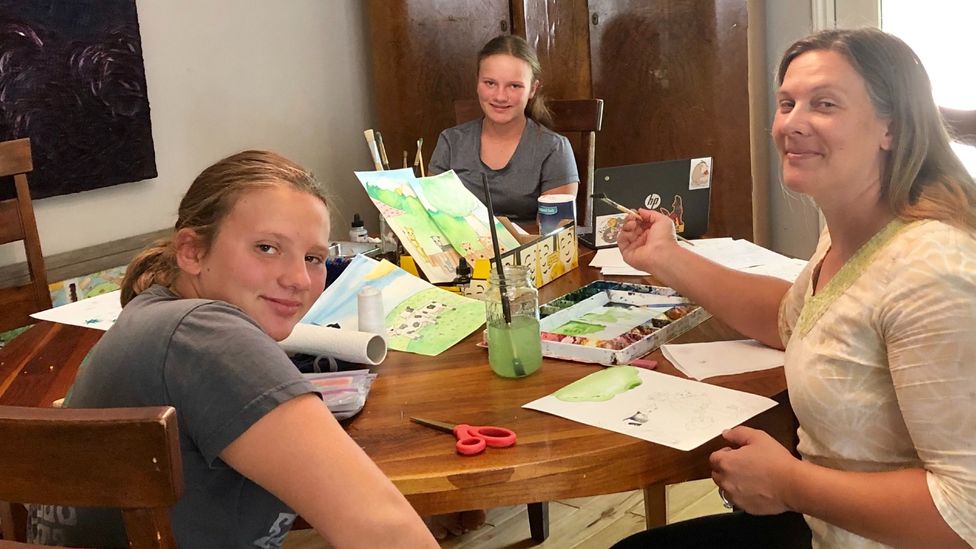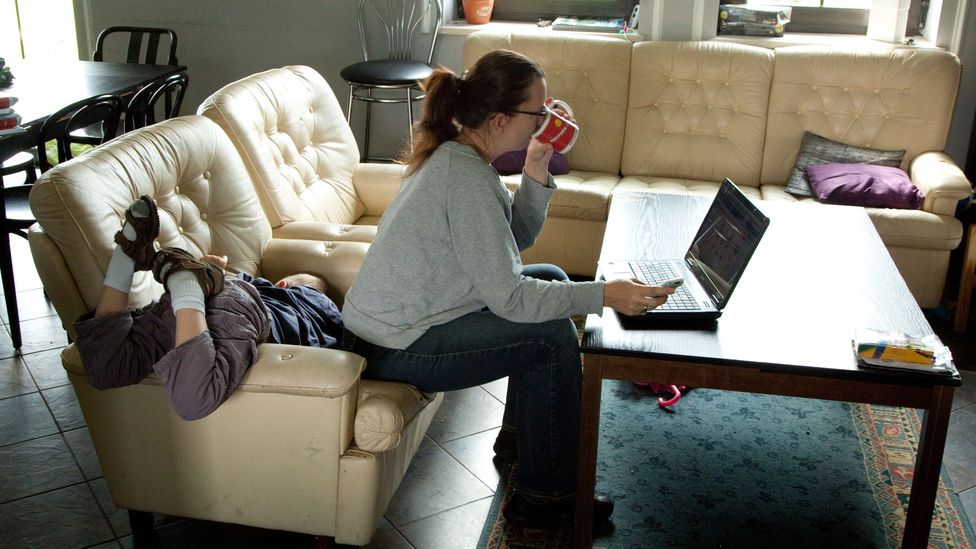Like many parents, when schools shut down due to Covid-19, Elizabeth Hunter found herself with more caregiving responsibilities as her three children transitioned to 100% remote classes. But her job also ramped up; as co-founder of bespoke science curriculum provider STEMTaught, the California-based Earth scientist had to figure out how her programme could remain hands-on in a virtual environment as well as work across time zones with authors and publishers to push out new editions of study materials faster.
Combining this increased workload – which included logistical components, like assembling and shipping learning kits, and scheduling online laboratory sessions with students – with her children’s schooling left few windows of quiet time in which she could really concentrate. Hunter started getting everyone to bed early and working late into the night to eke out some quiet time for creative work composing her curriculum, while tackling the more practical tasks during the day.
“I set a rule for myself. If the kids are sleeping and it’s not too late, instead of washing the dishes or doing housework; I’m working. I guard those stretches of time like diamonds – they’re so precious for me to be able to do my deep-thinking work,” she says.
It’s a challenge many of us are facing: we’re busier than ever, but still need pockets of uninterrupted time to do the work that requires our deepest focus. Popular theories suggest our most worthwhile work only happens after ‘Kondo-ing’ our distractions – that jettisoning mind clutter nudges us towards a flow state, an idyllic productivity paradise where creativity thrives. Before Covid-19, we might have used dedicated hours at the office or naturally productive peak hours when kids were at school to try and access ‘the zone’ for these concentration-heavy tasks.
Right now, accessing that kind of deep work zone can feel nearly impossible. If you’re busy with multiple tasks, finding a solid chunk of time for uninterrupted productivity may be utterly unrealistic. Fortunately, there are methods to optimise the limited ‘deep work’ time we have, plan for interruptions and produce meaningful work despite competing demands for our attention.

Elizabeth Hunter (R) uses quiet periods while her family are asleep to do her close-focus work (Credit: Elizabeth Hunter)
Separate tasks
There are multiple recommendations for creating an environment that will help you produce your best work.
Cal Newport, author of Deep Work: Rules for Focused Success in a Distracted World, suggests that most distractions are ‘controllable’ external stimuli that can be eliminated by grand gestures, such as checking into a hotel room to work, or quitting social media. Popular productivity app Trello recommends finding a place without people in your peripheral vision and investing in noise-cancelling headphones. Steven Kotler, executive director of the Flow Research Collective, a research and training organisation, recommends 90- to 120-minute chunks of uninterrupted focus in order to maximise flow.
Yet many of these are incompatible with our current realities; for most busy people, creativity and productivity cannot exist as siloed processes taking place in dedicated, impenetrable windows.
“We have this obsession with a lone artist working madly with almost divine inspiration,” says Pakistani contemporary artist Mahreen Zuberi, a mother of two. But in her creative practice, Zuberi separates her thinking and doing time, with most conceptualisation of her art completed early in the morning before her children wake up. She spreads execution across small pockets of time throughout the day because she knows attention and focus are precious commodities she must ration wisely, and it’s much easier to approach work in smaller chunks and pick up the actual implementation process where she left off.
Separating different aspects of the same task, as Zuberi does, makes sense. Many people use the ‘fringe hours’ to prioritise difficult tasks or special projects – but trying to cram in everything during early or late hours may be unsustainable as lack of sleep can hamper productivity (and children might wake up early, anyway). Working fringe hours consistently for all aspects of a task also reinforces the mindset that there’s one ‘slot’ for productivity, without the possibility of healthy overlaps with other responsibilities during the day.
Additionally, as Zuberi’s work pattern recognises, not all parts of a task require the same sort of focus, or the sequestered state that is so idealised. By determining which bits of a task require her most productive hours, she allocates them to times when she’s most likely to remain uninterrupted, giving her a greater chance of success.
Warming up
Once you’ve found a precious period of time to allocate to highly-focused work, Sophie Leroy, an associate professor of management at University of Washington Bothell, US, suggests preparing for that time-slot in advance can help you find your focus more quickly.
“Identify the most important task the night before. As you transition from non-work responsibilities the next morning, remind yourself of what you’ll be working on when you sit down. It’s like driving your car,” Leroy says, “You can gradually increase to 60 miles an hour, or get from 0 to 60 really fast.” Taking time to metaphorically warm up the engine early and set out with a clear sense of direction pays serious dividends, as opposed to hopping in and scrambling to figure everything out along the way.

Artist Mahreen Zuberi splits tasks into chunks - and allocates aspects that require deep focus to her most productive hours (Credit: Mahreen Zuberi)
Nausheen Shahzad, executive director of the Neuropsychology Center in Karachi, Pakistan, a privately-run clinic with a special focus on educational psychology and training, likens ‘warming up’ to a primary school teacher starting her lesson by asking children to sing their ABCs. “The learning objective isn’t to revise the alphabet. It’s to retrieve that file in their brain related to language so they can be more receptive to learning,” she says. That ‘brain activation’ can be applicable to busy adults, too. “Say you want to write an ode to flowers. You can start thinking about it even while you’re washing the dishes,” points out Shahzad.
Clearing our minds also helps us access deep concentration, so if stray worries or thoughts persist, computational neuroscientist Grace Lindsay from the Gatsby Computational Neuroscience Unit in University College London, who is also the author of Models of the Mind, recommends doing a quick ‘brain-dump’ – something as simple as scribbling in a notebook, or even sending an email to yourself about everything on your mind. “We know we can't hold a lot of things in our mind at once. While you’re focusing on deep work, minimise the number of things in your mind. Don’t connect to everything else.”
Plan for interruptions
Of course, finding slots for uninterrupted blocks of work may not coincide with the time of day we feel most naturally productive, according to our individual circadian rhythms. That means we either have to try and adapt our natural rhythms or start on a tough task in a slot where interruptions are inevitable.
Leroy, who studies both cognitive and emotional impacts of interruptions, says one strategy is to accept that interruptions will happen and thereby reduce their capacity to derail us. “Frustration, anger, stress and anxiety are the usual emotional responses to an interruption, and these negative emotions can easily spill over and make it difficult to focus following an interruption, impeding progress. By accepting [the fact that interruptions may occur] as our paradigm, we mitigate the likelihood for these negative emotions to occur. It’s never going to be, ‘Yay! I was interrupted,’ but it’s a very pragmatic approach,” she says.

For some, interruptions are just part of life – so learning to anticipate and cater for them can help (Credit: Alamy)
Leroy has also designed and tested the 'Ready to Resume' intervention to cope with the reality of interruptions. The idea, she says, is to “give your brain what it needs to function effectively in a context of frequent interruptions”. When she sits down to work, she keeps a sheet of paper on her desk, precisely with potential interruptions in mind, to quickly take stock of where she was in the task, and how she hopes to resume, before addressing the interruption. While testing the efficacy of the approach in the lab, Leroy found it took subjects very little time – a minute, or even five seconds – to bring cognitive closure and shift attention fully. This helped avoid attention residue, an unhelpful division of cognitive resources which occurs when thoughts about a previous task persist and intrude on the next one.
Strange times
It’s worth remembering, however, that while it might be possible to mine out more ‘diamonds’ of precious deep work time – and even use them more effectively – ultimately, these are strange times. Productivity and deep work can look very different depending on the person, profession, position, portion of the task itself – or in a pandemic. And sometimes, it may not look very glamorous.
The trick is to shift our expectations of what our working day might look like, and realise that productivity and creativity aren’t one-size-fits-all processes. Because whether we putter and splutter towards success or flow with ephemeral fluidity, we can all achieve our own version of the state of optimal performance, even while we’re busy.
As Lindsay says, “It’s incredibly different from person to person. This idea that you have to come up with the solution and there’s one and it's forever...it just doesn’t always align with everyone’s experience. There are a lot of different ways to be successful.”
"work" - Google News
April 29, 2021 at 02:00PM
https://ift.tt/3aXtEkO
How the busiest people get 'deep work' done - BBC News
"work" - Google News
https://ift.tt/3bUEaYA
Bagikan Berita Ini














0 Response to "How the busiest people get 'deep work' done - BBC News"
Post a Comment